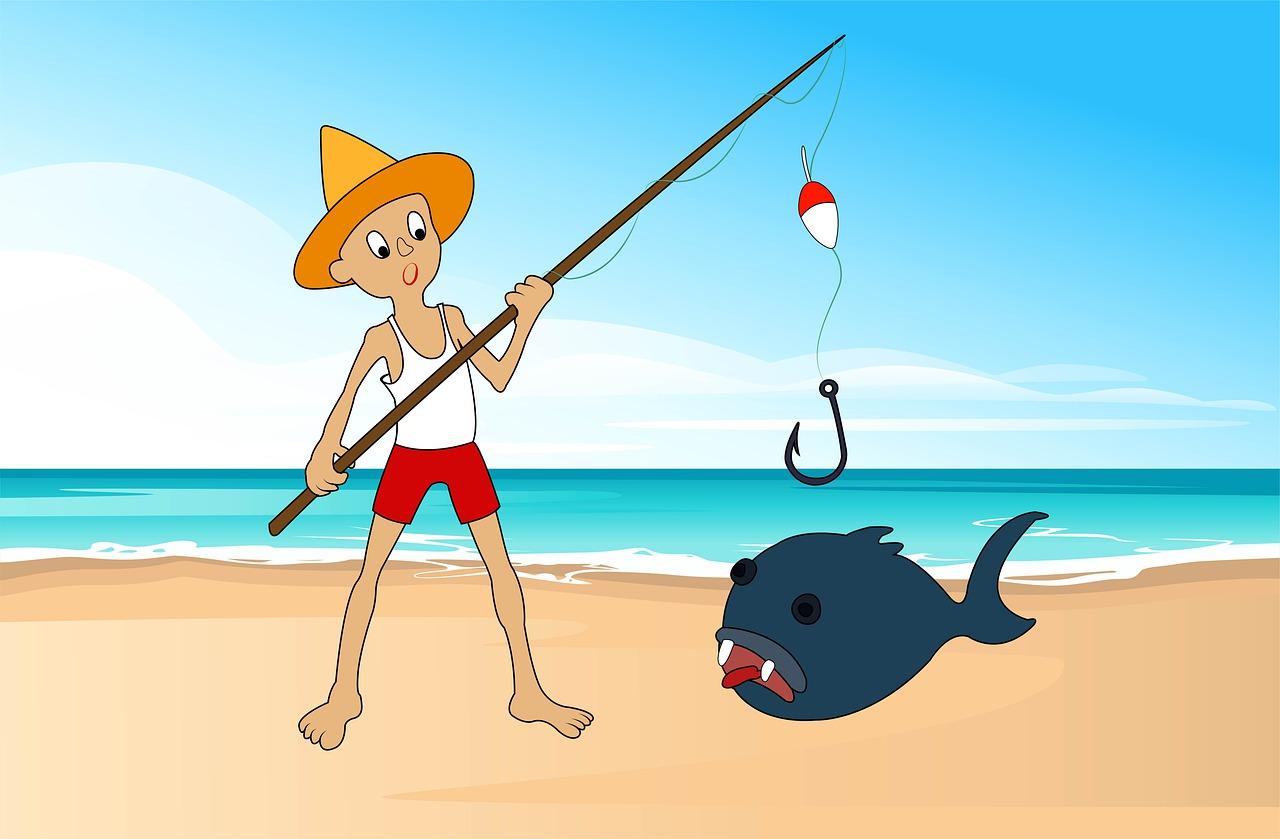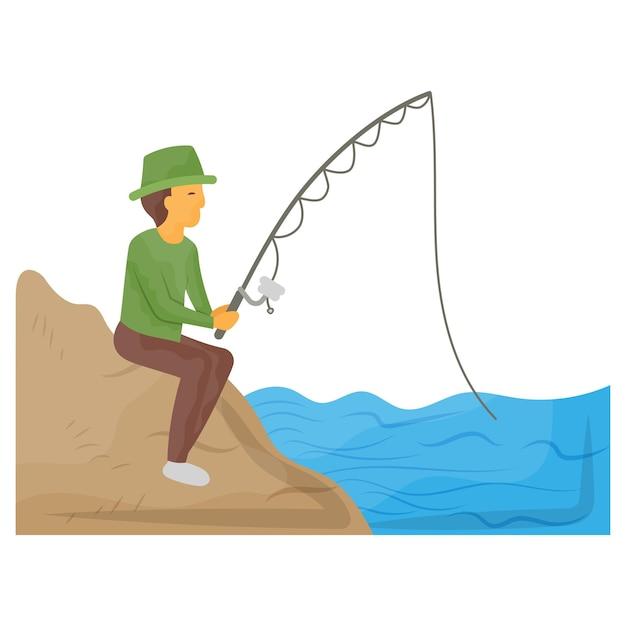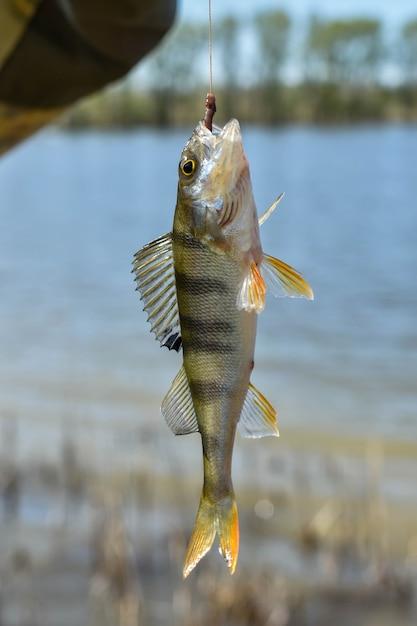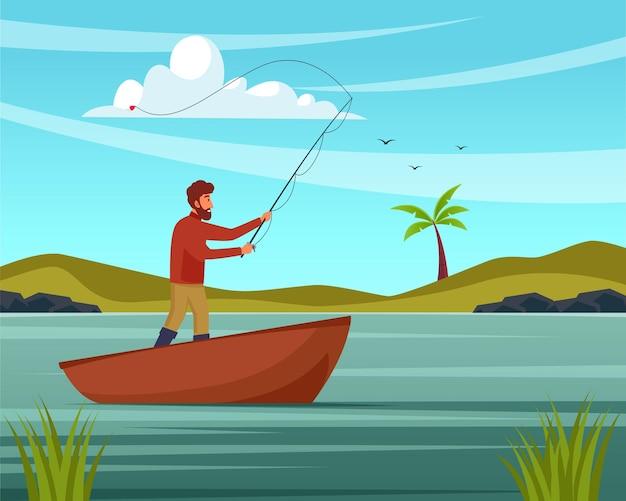Fishing is a popular pastime, loved by all ages and skill levels. The thrill of feeling a tug on your line and successfully reeling in a fish is like no other. But catching a fish on a line can be tricky, especially for beginners. In this comprehensive guide, we will delve into the art of catching a fish on a line. We will cover various topics such as the techniques for easy catching, what to do when you catch a fish, and how to tell if there is a fish on your line. You’ll be a pro at catching fish in no time!
The thrill of the catch
So, you want to catch a fish on a line, huh? Well, get ready for the ride of your life!
Equipment
First things first: you need the right equipment. You’ll want a strong line, a sturdy rod, and a reliable reel. Don’t be tempted to go cheap – trust me, you don’t want to lose a big one because of a faulty rod.
Bait
Now it’s time to find the perfect bait. While some people swear by live bait, others prefer lures or flies. It really depends on what type of fish you’re after. Just remember to keep it fresh – fish can smell last week’s bait a mile away.
Casting
Now for the fun part – casting your line! Get a good grip on your rod, pull it back, and let go with a flick of the wrist. It’s a lot like throwing a baseball, except you’re throwing a tiny piece of metal into the water.
Patience
Here’s the thing about fishing: it requires a lot of patience. You might cast your line a few times and not get any bites. But don’t give up! Sometimes it takes a while for the fish to come to you.
The Catch
Finally, you feel a tug on your line. Get ready for the fight! Reel it in slowly, and don’t get too excited. Fish are slippery little creatures, and you don’t want to lose your catch at the last minute.
The Release
Congratulations! You’ve caught a fish on a line. Now what? If it’s legal and safe to do so, you can release it back into the water. Or, if you want to keep it, make sure you know how to clean and cook it properly.
Catching a fish on a line can be a thrilling and rewarding experience. Just remember to have the right equipment, fresh bait, patience, and a strong wrist. Happy fishing!
Reeling in a Fish: What Does It Mean
If you’re new to fishing, the chances are that you’ve heard the phrase “reel in a fish” thrown around. So, what does it mean?
Well, it’s simple. When you hook and catch a fish, the next logical step is to “reel it in.” Essentially, you’re using the reel on your fishing rod to wind the fishing line back in, bringing the fish closer to you.
Now, you may be thinking, “Okay, but how hard can it be?” Let me tell you, reeling in a fish is no walk in the park.
The Struggle is Real
First, you need to make sure that you’re not using too much force, or you risk snapping the line and losing the fish altogether. But, at the same time, you can’t be too gentle, or the fish will have enough wiggle room to break free.
Then there’s the issue of timing. You have to keep a steady pace and maintain a smooth tension on the line while the fish puts up a fight.
The Art of Reeling
But fear not, young grasshopper. Reeling in a fish is a skill that can be honed with practice.
One tip is to use your entire body to reel in the fish, not just your arms. This will give you more power and control, making it easier to land the prized catch.
Another helpful strategy is to keep the rod tip up and use a pumping motion to bring the fish closer. This technique makes it harder for the fish to take off and keeps the fishing line tight.
Overall, reeling in a fish takes patience, skill, and a bit of luck. But with enough practice and determination, you’ll be able to bring that big catch to shore and impress all your fishing buddies.
So, the next time someone tells you to “reel in a fish,” you’ll know exactly what they mean. And who knows? You might even become a pro at it someday.
How to Catch Fish Easily
Fishing is a fun and relaxing activity that can be enjoyed by anyone, whether you’re a seasoned angler or a curious beginner. However, catching a fish on a line can be challenging, especially if you don’t know what you’re doing. Fear not, my friend! I’ve got some tips and tricks to help you catch fish easily without breaking a sweat.
Choose the Right Bait
Different fish species have different preferences when it comes to bait. If you’re fishing for bass, consider using worms or minnows as they tend to be attracted to live bait. Alternatively, if you’re targeting catfish, try using stink bait or chicken liver as they love the smell of rotting meat.
Use the Right Equipment
Using the right fishing equipment can make a world of difference. Make sure you have a fishing rod that’s appropriate for the size of the fish you’re trying to catch. A lightweight rod is ideal for catching small fish, while a heavier one is necessary for bigger fish. Additionally, ensure your fishing line is strong enough to withstand the weight of the fish.
Go Where the Fish Are
Knowing where to fish is crucial to catching fish easily. Research the type of fish you’re targeting and find out where they tend to hang out. Fish are often found near structures such as rocks, weeds, and fallen trees. You can also ask locals or experienced fishermen for tips on the best fishing spots in the area.
Be Patient
Catching fish may take some time, so be patient. Keep in mind that fish have their own schedule and may not be hungry when you’re fishing. It’s important to have a calm and relaxed attitude and enjoy the process regardless of the outcome.
Catching fish on a line can be a rewarding experience that provides a sense of accomplishment. By following these tips, you’re sure to increase your chances of catching fish easily. Remember to respect the environment and always follow fishing regulations in your area. Happy fishing!
What is the Angling Technique
So you want to catch a fish on a line, eh? Well, it’s not as simple as just casting your line into the water and waiting for a fish to bite. You need to use the proper angling technique if you want to increase your chances of success.
Understanding Angling
Angling is the art of catching fish using a line and a hook. It’s important to note that angling isn’t just about catching fish. It’s also about enjoying the outdoors, spending time with friends or family, and relaxing. So, let’s get started with understanding the basics of angling.
The Basics of Angling
To start with, you need to choose the right gear for your fishing needs. This includes selecting the correct rod and reel for the type of fishing you’ll be doing. Once you’ve got your gear, you need to select the appropriate bait for the type of fish you’re hoping to catch.
Casting Your Line
Now that you’ve got the gear and the bait, it’s time to cast your line. The key to a good cast is to use a smooth and fluid motion. First, hold the rod with both hands and grasp the line with your index finger and thumb. Then, using a flicking motion of your wrist, send the bait out into the water.
Patience is Golden
After casting the line, sit back, and wait. It’s called fishing, not catching, for a reason, so be patient. It can take a while for fish to notice your bait and take a bite, so make sure to enjoy the scenery and relax while you wait.
Reeling in Your Catch
Once you feel a tug on your line, it’s time to reel in your catch. Remember, it’s important not to jerk or pull your line too hard, or you may lose the fish. Instead, use a slow and steady motion to reel in your catch. And voila, you’ve caught yourself a fish!
In conclusion, angling is not only a great way to catch fish, but it’s also an enjoyable way to spend your day out in the sun. Whether you’re a beginner or a seasoned angler, using the proper angling technique will increase your chances of catching that big one. So, get out there, cast your line, and enjoy the great outdoors!
What To Do When You’ve Caught a Fish
Fishing is not only a relaxing pastime but also a satisfying one, especially when the fish finally bites and you reel it in. However, you must know what to do next once you’ve caught a fish, or you could end up with an injured fish or worse, lose it. Here are some tips to help you handle the situation with ease:
1. Stay Calm and Keep Your Grip Firm
Congratulations! You’ve caught a fish. Now, in all the excitement, don’t forget to stay calm. A sudden jerk or pull could break your line or hook. With that said, grip your fishing rod firmly and maintain a steady tension on the line. With your other hand, hold the fish by its lip or gill cover.
2. Remove the Hook
Next up, gently remove the hook from the fish’s mouth. If the hook is firmly embedded, use a pair of pliers or a hook remover tool. Ensure that you don’t injure the fish or yourself.
3. Take a Quick Picture
Did anyone say “Proof of Catch”? Take a quick picture of the fish, if possible. However, don’t keep the fish out of the water for more than a few seconds.
4. Release or Keep the Fish
If you’re fishing for fun, release the fish back into the water. Gently lower the fish into the water and let it swim away. However, if you’re keeping the fish for consumption, place it in a cooler or on ice to keep it fresh until you get home.
5. Clean Up and Get Back To Fishing
Once you’re done, it’s time to clean up, bait up your hook and get back to fishing. Remember: fishing is a game of patience, so if nothing bites for a while, don’t worry.
By following these simple steps, you can handle your catch like a pro, making the whole experience enjoyable for both you and the fish!
Catching a Fish on a Line of Sight
There’s nothing more rewarding than catching a fish on a line of sight. It’s like the fish is saying, “Hello there, I see you, and I accept your challenge!” But catching a fish on a line of sight is easier said than done. Here are some tips to help you reel in that elusive fish.
Know Your Fish
Different fish behave differently in the water. Some prefer to stay in shallow waters, while others prefer to hang out near rocks or trees. Knowing your fish’s habits and tendencies will help you determine the best spot to catch it.
Get Closer
The closer you are to the fish, the better your chances of catching it. But don’t get too close, or you’ll scare it away. Approach the fish slowly and quietly. If you’re in a boat, try to get as close to the water as possible without making any noise.
Use the Right Bait
Different fish prefer different bait. Some fish like worms, while others prefer flies. Do some research on the type of fish you’re trying to catch, and find out what kind of bait they like best.
Be Patient
Catching a fish on a line of sight takes time and patience. The fish may not be hungry or may be too wary to bite. Don’t give up too quickly. Keep trying different techniques and bait until you find something that works.
Watch the Weather
The weather can have a big impact on fishing. Some fish are more active during certain times of the day or in certain weather conditions. Keep an eye on the weather forecast and plan your fishing trip accordingly.
Catching a fish on a line of sight is a challenging and rewarding experience. With the right knowledge and technique, you can increase your chances of catching that elusive fish. Just remember to be patient, use the right bait, and watch the weather. Happy fishing!
Can You Fish Without a Fishing Pole
So, you are stranded in the middle of nowhere with a vast lake teeming with fish. However, you don’t have a fishing pole with you. Well, the good news is that you can still fish without one.
Use a Stick
Find a long and sturdy stick, preferably around 6 to 7 feet long. Whittle one end into a sharp point, and use it to spear fish in shallow waters. Alternatively, you can tie a string to the end of the stick, attach a hook, and bait it with worms or insects. The downside of this method is that you will need to be close to the fish to catch them.
Use a Net
A fishing net can be made out of a variety of materials, including nylon, cotton, and even vines. Tie the material onto a makeshift frame made from branches or bamboo sticks, and anchor it with rocks or weights. Walk around the lake, submerging the net and waiting for fish to swim into it. This method requires some patience, but it’s also one of the easiest ways to catch fish without a fishing pole.
Use Your Hands
Yes, you read that right. Fishing with your hands is a technique often called “noodling” or “hand-fishing.” Dive into the water and search for a fish hiding spot, such as a crevice or log. When you find a fish, use your hands to grab it by the mouth or gills. It takes some courage and skill to master hand-fishing, but it’s a fun and rewarding way to catch fish.
As you can see, it’s entirely possible to fish without a fishing pole. All you need is some creativity, resourcefulness, and a bit of luck. While these methods may not be as efficient or easy as using a fishing pole, they can be a lot of fun and a great survival technique. So, the next time you are without a fishing pole, give one of these methods a try!
How to Catch Big Fish on a Light Line
Let’s face it: fishing is not only about waiting for a fish to bite, but also about catching the biggest fish you can. And what’s more satisfying than catching a big fish on a light line? It’s like David beating Goliath.
Choose the Right Line
When fishing for big fish on a light line, choose a line with a high breaking point. Fluorocarbon is a popular choice for light lines because it is invisible underwater and has a high breaking point. Braided lines are also a good option because they are thinner and stronger, but they can be visible to fish.
Use a Light Rod
Using a light rod is important because it allows you to feel the fish’s movements and hook it properly. A light rod also makes it easier to cast with a light line and to detect bites. Look for a rod with a sensitive tip and a strong backbone.
Bait and Lure Selection
Choosing the right bait or lure is crucial when fishing for big fish on a light line. Use a bait or lure that mimics the fish’s natural prey to increase your chances of catching it. Live bait such as minnows or worms are a good option. If you prefer using lures, try using a jig or a soft plastic bait.
Reel in Slowly and Steadily
When you get a bite, avoid jerking the line too hard as it may cause the line to break. Instead, reel in slowly and steadily to tire out the fish. Use your rod to keep tension on the line and prevent the fish from running.
Bring a Net
Always bring a net when fishing for big fish on a light line. A net allows you to safely land the fish without injuring it or breaking your line. Once you have successfully caught the fish, take a quick photo to capture the moment before releasing it back into the water.
With these tips, you are now equipped to catch big fish on a light line. Keep in mind that practice makes perfect, so don’t get discouraged if you don’t catch a big fish on your first try. Happy fishing!
How to Know if You Have a Fish on Your Line
Have you ever felt a tug on your fishing line and wondered if it’s a fish or just the current? Well, you’re not alone. Below are a few ways to tell if you have a fish on your line:
Watch the Line
The easiest way to tell if you have a fish on your line is by watching your line. If your line starts to move, it’s a good indication that something is tugging on it. A fish would typically swim away from you, causing the line to move.
Check the Rod
Another way to tell if you have a fish on your line is to check your rod. When a fish bites, it will often cause your rod tip to bend down. If you see your rod bending, it’s time to reel in and see what you’ve caught.
Wait for a Second Tug
Sometimes a fish will nibble on your bait without fully taking it. If you feel a small tug, wait a few moments to see if the tug is followed by a more substantial one. This could be an indication that the fish has fully taken the bait and is ready to be reeled in.
Listen for Sounds
Fish make sounds underwater, and you may be able to hear them splashing around if you have a fish on your line. Listen for any sounds coming from the area where you cast your line. If you hear any splashing or churning sounds, it’s a good sign that you’ve caught something.
With practice, you’ll be able to tell if you have a fish on your line without even seeing it. Remember to stay patient, and to enjoy every moment of the fishing experience!



